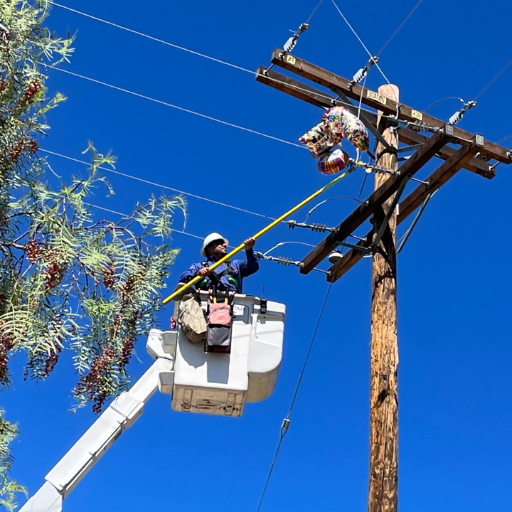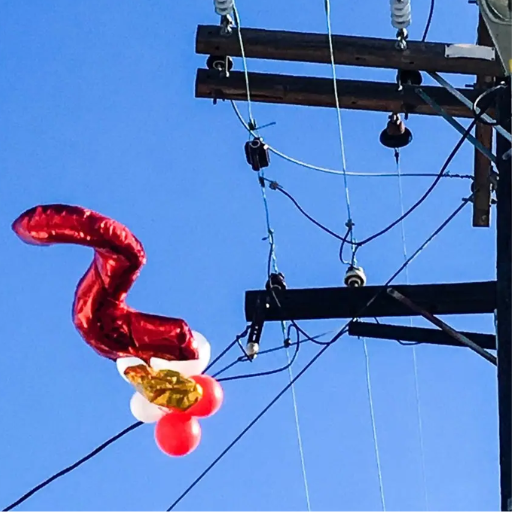Balloons can seem innocuous enough, but the situation could turn unexpectedly chaotic and dangerous when they come into contact with power lines. Metallic balloons are notorious for causing annual power outages, disrupting communities, and presenting significant safety hazards. Then why do balloons explode on power lines, and how does this cause outages? The blog post explores the science behind the phenomenon and discusses how a cheerful party favor turns hazardous to power systems. Dig into the strange link between balloons, electrical disruptions, and methods to avoid incidents.
How Do Balloons Cause Outages?

When balloons touch power lines, they may cause outages. Metallic balloons are the best conductors due to their metal coating. When balloons touch power lines, they can short-circuit or cause an electrical fault, interrupting the flow of electricity. This can also cause an outage, damage equipment, and sometimes cause fires. This causes latex balloons if their strings or material get tangled with power lines or electric equipment. Prevention is simple: always ensure the balloons are tied securely; never release them outside; and dispose of them properly after use.
Why Do Balloons Explode on Power Lines?
The electrical characteristics of the materials used, combined with the high voltage running through power lines, can lead balloons to explode or cause severe damage. Metallic or Mylar balloons are considered even more dangerous simply because their metallic coating can conduct electricity. When metal balloons come into contact with the power lines, they cause a surge that may short the circuit or cause power outages. However, recent data shows hundreds of power outages yearly due to balloon-related incidents. For instance, in the U.S., utility companies reported over 1,000 outages in 2022 alone that were caused by metallic balloons.
If, during flight, a balloon shapes through the power lines, a high current in the lines is enough to generate a high-heat arc, which is sufficient to ignite the balloon and cause explosions or melting of the surrounding material. Even the latex ones may become nuisances if their strings or another external agent are conductive and in closer contact with a high-voltage source. Utility companies often report such cases during celebrations for graduations or holidays when balloon use is at its peak. Mitigation efforts include spreading awareness so that people know how to properly dispose of balloons and never allow them to be released outdoors; some jurisdictions have gone even further by enacting legislation that bans balloon releases outright for the protection of wildlife and infrastructure.
Why do Mylar balloons pose a higher risk?
- Conduction: Being a precious metallic material, Mylar balloons conduct electricity, thus increasing the chance of a blackout and creating an electrical hazard of sorts should they accidentally come into contact with electric towers. Studies, for one, have shown Mylar balloons to be one of the essential causes of preventable outages in certain urban areas.
- Durability: Also, unlike latex balloons that can still be easily broken down by Nature, being made of Mylar renders the balloons much more durable. They will persist in the environment for months before decomposing. Such presence, therefore, leads to chronic hazards to wildlife and infrastructure, raising environmental costs.
- Maximum Floating Height: A Mylar balloon with helium floats at higher altitudes than many latex balloons. Upon release, it becomes a potential menace when it gets caught in power lines or other aerial infrastructure.
- Difficult and Slow Biodegradation: The Mylar balloons do not easily biodegrade. Their metallic coating and synthetic nature urge a proper disposal method because they may harm ecosystems and marine species that consider them food.
- Visibility: The scenarios other than Novelties, including glare, draw attention from Mylar balloons and tend to distract motorists and pilots. Having been recorded in such cases of accidents, this has brought forth a significant and unexpected public safety issue.
Being aware of these risks will go a long way toward preventing accidental releases and enforcing responsible balloon use.
Exploring the science behind balloons exploding on power lines
|
Key Point |
Details |
|---|---|
|
Material |
Mylar balloons have metallic, conductive coatings. |
|
Conductivity |
Metallic coating conducts electricity, causing short circuits. |
|
Impact on Power Lines |
Contact causes sparks, outages, and equipment damage. |
|
Duration of Inflation |
Mylar balloons stay inflated longer, increasing the risk. |
|
Frequency of Outages |
Up to 20% of outages are caused by balloons annually. |
|
Safety Risks |
It can lead to fires, downed wires, and injuries. |
|
Environmental Concerns |
Harm wildlife and create litter when improperly disposed. |
|
Prevention Tips |
Keep balloons tethered, indoors, and puncture before disposal. |
|
Utility Recommendations |
Never retrieve balloons from power lines; call utility services instead. |
|
Notable Incidents |
Outages have affected thousands, e.g., 15,000 in Jersey City. |
What Are the Consequences of Balloon Explosions on Power Lines?

Premature balloons popping on power lines result in a hazardous disruption of electric systems. This is because the metallic coating on some balloons does conduct electricity, resulting in short circuits and subsequent loss of electricity. This loss of electricity may become widespread to the extent of disrupting homes, businesses, and services of importance. Besides, repairing power lines requires a considerable amount of time and money. Another huge safety concern presents itself with such explosions in the form of dangers of fires or damage to the equipment-owner, on which a greater emphasis should be laid on keeping balloons away from power lines.
How Balloons Cause Power Outages
Balloons, particularly metallic or Mylar ones, conduct electricity and create major disruptions when they come into contact with power lines. These balloons are usually accidentally released into the air; as they drift toward electrical infrastructure, their metallic coating can create a short circuit or even an arc. Utility companies estimate that balloons cause thousands of outages per annum. For example, Southern California Edison recorded nearly 1,100 power outages in 2022 due to balloons, with thousands of customers affected.
Depending on the severity of the impact, consequences may be short-lasting or huge disturbances. Outs, however, may also damage particular power distribution equipment, such as transformers, and set the conditions for fire. The complexity in repairs translates to more costs borne by the utilities and longer times to restore power. To tackle such problems, electric companies advise that balloons be tied down firmly and always carry a weight; after use, balloons should be deflated appropriately and disposed of. Many regions thus promote awareness campaigns about whether or not it is safe to release balloons into the environment.
Examining the impact of power outages caused by balloons
|
Key Point |
Details |
|---|---|
|
Affected Areas |
Urban and suburban areas with power lines. |
|
Frequency of Outages |
Hundreds of outages annually from balloons. |
|
Affected Customers |
Tens of thousands lose power per incident. |
|
Economic Impact |
Disrupts businesses, schools, and hospitals. |
|
Environmental Impact |
Balloon debris harms wildlife and ecosystems. |
|
Safety Risks |
Sparks, fires, and downed power lines. |
|
Notable Incidents |
15,000 customers affected in Jersey City outage. |
|
Prevention Measures |
Keep balloons tethered and puncture before disposal. |
|
Utility Costs |
High repair costs for damaged equipment. |
|
Public Awareness |
Campaigns to educate on balloon safety. |
How often do these incidents lead to a blackout?
The statistics suggest that incidents that trace back to balloons are responsible for only a small percentage of total insurance liability annually.
Why Are Balloons a Common Hazard Near Power Lines?

Balloons are a common hazard around power lines because metallic or foil balloons can conduct electricity. When such balloons come into contact with the power lines, they may cause an electrical short circuit or fault, thus causing power to go out and even damaging parts of the grid. Furthermore, balloons usually have strings or tethers attached to them, which can become entangled in equipment, causing further risk of disruption. Since they are lightweight, the wind may carry them into hazardous areas around electrical infrastructure.
Understanding the celebration culture and balloon releases
Several celebrations have chosen a balloon release to symbolize joy, remembrance, or unity. I sympathize with how people would treasure it, for a balloon release can feel like sending a message or a wish into the sky. However, the view has changed with the knowledge of their impact on the environment and infrastructure. Let safe and environmentally friendly alternatives be considered so they can carry out the festive spirit without harm.
The role of helium and foil balloon coatings in incidents
|
Key Point |
Details |
|---|---|
|
Helium’s Role |
Keeps balloons buoyant, increasing the risk of contact with power lines. |
|
Foil Coating Material |
Made of metallic, conductive material. |
|
Conductivity of Coating |
Metallic coating conducts electricity, causing short circuits. |
|
Inflation Duration |
Foil balloons stay inflated longer than latex balloons. |
|
Risk of Contact |
Prolonged inflation increases chances of power line contact. |
|
Impact on Power Lines |
Causes sparks, outages, and equipment damage. |
|
Safety Hazards |
Can lead to fires and downed power lines. |
|
Environmental Concerns |
Metallic debris harms wildlife and ecosystems. |
|
Prevention Tips |
Avoid releasing balloons; puncture before disposal. |
|
Utility Recommendations |
Call professionals if balloons come into contact with power lines. |
Why are balloons made with metallic elements risky?
An immense threat to the environment and infrastructure is posed by balloons with metallic elements, or foil balloons, as they are commonly called. These threats come about due to the metallic coatings being used and the conductive properties of such materials. Here are the details and examples that show why these balloons can present dangers:
- Electrical Hazards
Metallic balloons are conductive, so if they come in contact with power lines, they can cause power outages and other electrical interruptions. Utility companies indicate that power outages from metallic balloons number in the hundreds in several jurisdictions and cause major downtime and economic loss.
- Environmental Pollution
The metallic coating on foil balloons cannot be believed to biodegrade, so it simply becomes litter in natural ecosystems. This debris can hurt wildlife when eaten or caught, thereby upsetting the ecological balance.
- Fire Hazards
Sparking can occur when these balloons come in contact with power lines, and the spark may cause a fire. The risk escalates with these incidents in fire-prone areas during the dry season.
- Collision Risks to Aircraft
Metallic balloons floating in the atmosphere and released can reach heights that interfere with aircraft operations, posing safety concerns to the pilots and passengers.
- Difficulties in Disposal
Non-biodegradable metallic balloons cannot be sustainably disposed of. Metallic balloons that refuse to degrade pollute the land since they cannot degrade on their own after being disposed of, unlike latex ones that degrade under certain circumstances.
Knowing about these risks nurtures the importance of responsible balloon use, proper disposal, and appropriate regulation of metallic balloon releases.
How Can We Prevent Outages Caused by Balloons?

- Public Education
Make the public aware that releasing metallic balloons may result in power outages. Inform them about the environmental and safety risks.
- Promote Alternatives
Such as encouraging phosphogypsum balloons with non-metallic or biodegradable materials that pose less risk to power lines.
- Impose Restrictions
Apply or encourage the application of laws restricting the release of metallic balloons and their disposal.
- Secure the Balloons
Advising the public to attach weights to balloons so they would not accidentally drift into the sky.
Carrying out these would drastically lessen the balloons’ hazards on power lines, thereby maintaining a safe and reliable energy grid.
Tips to Keep Balloons from Hitting Power Lines
- Choose Non-Conductive Materials
Metallic balloons can be considered the main perpetrators of the power outages attributed to such balloon crises. One might opt for latex or any other non-conductive type of balloon so that endangerment of power lines is minimized as much as possible. The utility companies report that metallic balloons account for thousands of power outages each year in the United States alone, with some cases affecting thousands of homes and business establishments.
- Properly Secure Balloon Strings
Make sure that all balloons are secured by strong string and attached to a sufficient weight. Safety guidelines from large utilities recommend a balloon weight of at least 6 ounces to prevent accidental release.
- Avoid Outdoor Use Near Power Lines
If celebrating outdoors, keep the balloons far from power lines. Data from the Electrical Safety Foundation International indicates that balloon drifting into power lines causes a significant proportion of electrical disruptions, incurring repair costs and loss of productivity in the order of millions of dollars annually.
- Dispose of Balloons Responsibly
Deflate and discard the balloons appropriately after use to circumvent environmental hazards and lessen the likelihood of them being swept away into the sky. If latex balloons are discarded outdoors, they degrade quickly, differentiating them from metallic balloons that will stay intact for longer.
- Educate and Create Awareness
Education will significantly lessen the hazards involving balloons. Many public utility companies and environmental groups are supporting mass awareness campaigns. There have been noticeable decreases in balloon-related incidents in California since public safety advertisements and educational programs began.
Those steps, along with the spreading of awareness, have greatly reduced the instances of balloons hitting power lines, allowing for safer celebrations and avoiding unnecessary outages.
How proper tethering can prevent balloons from exploding
|
Key Point |
Details |
|---|---|
|
Definition of Tethering |
Securing balloons with a weight to prevent drifting. |
|
Prevents Power Line Contact |
Keeps balloons grounded, avoiding power line interference. |
|
Reduces Outage Risks |
Prevents short circuits and power disruptions. |
|
Minimizes Safety Hazards |
Avoids sparks, fires, and downed wires. |
|
Environmental Benefits |
Prevents balloon litter and wildlife harm. |
|
Tethering Materials |
Use strong, non-conductive strings and weights. |
|
Event Safety |
Essential for outdoor celebrations near power lines. |
|
Utility Recommendations |
Always tether balloons to prevent accidents. |
|
Disposal Advice |
Puncture balloons after use to avoid drifting. |
|
Public Awareness |
Campaigns emphasize tethering to reduce incidents. |
Warnings and Guidelines from Power Company and Utilities
Utilities and power companies end up warning the public and issuing recommendations for their safety so that accidents involving balloons can be prevented. Here are a few important recommendations:
- Always tie a weight to balloons
If released, the wind will likely carry helium balloons into power lines. Therefore, they should always be tied to a heavy object.
- Never release balloons into the air
A balloon released over land will invariably be caught in some electrical equipment, causing power disruption and safety hazards.
- Conductive materials should not be used for strings
Balloons tethered with metallic ribbons or strings can electrocute a person or cause severe electrical damage and outages if they , in turn, touch wires.
- Deflate and dispose of balloons.
After celebrations, balloons should be deflated and disposed of properly in the environment to lessen risks and environmental littering.
- Stay away from power lines.
Stay away from power lines and utility poles with balloons, especially bigger ones, so you don’t accidentally come in contact with them and get electrocuted.
Thus, if individuals or communities practice these norms, they will contribute to the maintenance of safety and will avoid disruptions that could have easily been prevented due to a balloon case.
What Are the Trends in Balloon-Related Outages Over the Past Five Years?

Over the last five years, a clear pattern showing seasonal peaks emerged from the history of balloon outages, with celebrations and events such as graduations, parties, or holidays acting as win-win circumstances, causing the incidents to peak. Most of these outages ensued from metallic balloons by coming into contact with power lines, which led to short circuits and power failures. Campaigns and increased awareness probably helped lessen incidents in some localities; however, the overall trend suggests that vigilance and education must be pursued with intensity.
How have outages every year changed over time?
Through the years, power outages caused by metallic balloons have gone up and down. However, if there is one trend, it is worrying about metallic balloons since they are increasingly used now, particularly during events. Annually, power companies report thousands of outages caused by metallic balloons, with some witnessing a double-digit per cent increase yearly. In 2022, Southern California Edison recorded 1103 outages due to balloons, a rise of about 16 per cent compared to the previous year. Pacific Gas and Electric also recorded a steady rise in metallic balloons, causing power disruptions that inconvenienced almost 200,000 customers during 2021.
Thanks in part to recent safety campaigns and technological advancements, such as warnings on foil balloons and weighted designs, incidents in some regions have been curbed somewhat. Nevertheless, as the popularity of decorative metallic balloons sets sail to a greater scale, it remains foremost if awareness and education on safe handling practices are kept afloat. The top public initiatives and strict regulations will be the turning points in stopping the upward trajectory and curtailing the widespread use of metallic balloons on power grids.
Statistics on outages caused by balloons in recent years
|
Key Point |
Details |
|---|---|
|
Annual Outages in California |
Over 650 outages reported in one year. |
|
Virginia Outage Impact |
14,600 families affected in a single incident. |
|
Arizona Outages (2018-2019) |
146 outages affecting 63,000 customers. |
|
Los Angeles Outages |
510 outages caused by balloons in one year. |
|
Washington D.C. Area (2020) |
101 outages affecting 8,254 customers. |
|
Percentage of Total Outages |
Up to 20% of outages are caused by balloons. |
|
Major Incident Example |
15,000 customers affected in Jersey City outage. |
|
Seasonal Trends |
Peaks during holidays and celebrations. |
|
Economic Impact |
Significant costs for repairs and lost productivity. |
|
Environmental Impact |
Balloon debris adds to ecological damage. |
What measures have been taken to reduce these incidents?
Punitive measures have been initiated to curb crimes against and threats to these areas. These include public awareness campaigns to educate communities about the dangers balloons pose to power infrastructure and the environment. Other activities include working with local authorities and organizations to promote alternative, safer decorations for use during celebrations. Increased monitoring and quick response teams were put in place to ensure the speedy handling of outages caused by balloons and to minimize impact.
References
-
Riverside Government Website: This source explains how loose balloons can cause explosions, power outages, and other hazards when they come into contact with power lines.
-
City of Palo Alto Utilities PDF: This document highlights the dangers of Mylar balloons, including their potential to explode and catch fire upon contact with power lines.
-
NOAA Response and Restoration: While this source primarily discusses environmental impacts, it also discusses the risks associated with released balloons.
Frequently Asked Questions (FAQ)
Q: Why do balloons explode when they come into contact with power lines?
A: Balloons, especially metallic balloons, can cause a short circuit when they come into contact with power lines. Their metallic coating is conductive, allowing electricity to flow through them, which can cause them to explode and potentially lead to power outages.
Q: How can balloons cause thousands of power outages each year?
A: Metallic balloons floating away and entangled in an overhead power line can cause short circuits. These incidents can lead to power outages, as the lines are energized and the electricity is disrupted. They often affect large areas and cut power to homes and businesses.
Q: What should I do if I see a balloon entangled in an overhead power line?
A: If you see a balloon or any object entangled in an overhead power line, do not attempt to retrieve it. Contact your local utility company, such as PG&E, to report the situation. Retrieval attempts are hazardous and should be handled by professionals.
Q: Are rubber balloons safe near power lines?
A: While rubber balloons are less conductive than metallic ones, they can still pose a risk if they drift into power lines and cause a tangle. It’s best to avoid having balloons near power lines to ensure public safety.
Q: How can I prevent balloons from causing power outages?
A: To prevent balloons from causing power outages, always dispose of them properly and ensure they are tethered securely. Avoid releasing them outdoors, where they can float away and potentially come into contact with power lines.
Q: What are the dangers of downed power lines caused by balloons?
A: Downed power lines are hazardous as they can still be energized, posing a risk of electrocution and fire. If you encounter downed power lines, warn others to keep away and contact emergency services immediately.
Q: Why should I warn others about the dangers of metallic balloons?
A: Metallic balloons are fun but can be hazardous when they drift into power lines. Educating others about the risks, such as the potential for power outages and public safety hazards, helps prevent such incidents and promotes safe balloon use.
Q: What steps can I take to ensure balloons do not float away?
A: Always keep balloons tethered and supervise them closely if used outdoors. Ensure they are securely tied to weights and never release them into the sky, as they can drift into power lines, causing outages and other hazards.
Q: How do metallic balloons cause a short circuit in power lines?
A: Metallic balloons have a conductive coating that can cause a short circuit if they contact power lines. The electricity can travel through the balloon, energize it, and cause the balloon to explode, leading to possible power disruptions and hazards.









